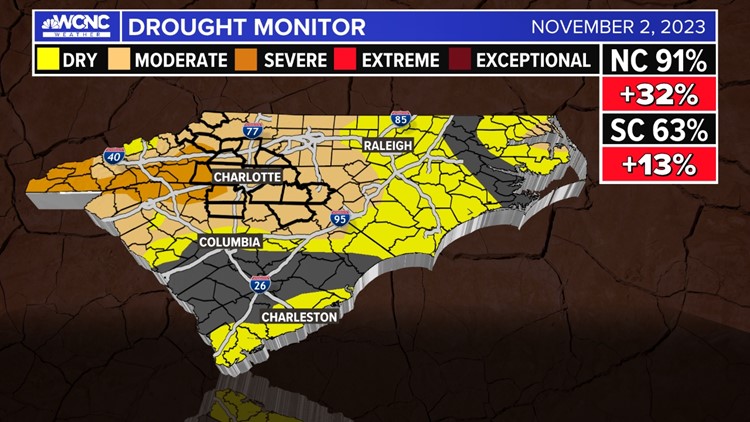CHARLOTTE, N.C. — The first United States Drought Monitor for the month of November was released Thursday morning showing an increase across both North Carolina and South Carolina. North Carolina's increase was 32% while South Carolina's was 13%.
The entire WCNC Charlotte viewing area, which stretches from Ashe County in the western North Carolina mountains back south and east through Charlotte to Chesterfield County in South Carolina, is under a moderate drought.
On the monitor's five-point scale of D1-D5, this is considered a D2.
Over 91% of North Carolina is under drier-than-normal conditions. This puts the number of residents under drought conditions at 5,612,153, according to the drought monitor. South Carolina's numbers are lower, just under two million people.
Drought conditions will become more concerning the prolonged stretch of mostly dry weather conditions.
For the latest weather alerts, download the WCNC Charlotte mobile app and enable push notifications.
Also on Thursday Duke Energy, who controls the water levels in the Catawba River, Lake Norman, and Lake Wylie through a series of dams, announced Stage 1 drought restrictions along the Catawba-Wateree River Basin. Stage 1 is the first phase of operational adjustments at Duke Energy's hydroelectric facilities. This level of restrictions encourages residents to voluntarily conserve water -- but the conservation is not mandatory.
“While some areas of the basin have received scattered rainfall, the lack of widespread and consistent precipitation along with warm temperatures have resulted in increased drought conditions,” said Ed Bruce, P.E., Duke Energy, CW-DMAG coordinator. “We will continue to monitor conditions and provide updates as needed to best protect the shared water supply available to our communities.”
As part of the Stage 1 operations at Duke Energy-controlled facilities, boaters may notice an impact on water levels. Duke Energy says it needs to reduce recreational flow hours as part of reducing downstream flow through its dams.
Some boat ramps will close temporarily due to declining lake levels, Duke Energy said Thursday.
"Extra caution should be taken when launching boats at shallow ramps," Duke Energy says on its website. "User discretion at landings is advised until further notice."
The power company says ramps at Ramsey Creek Park, Buster Boyd Access Area, and Allison Creek Access Area are already at or below recommended levels.
Temporary boat ramp closures will be listed on the Duke Energy Lakeview app and at https://Duke-Energy.com/Lakes.
Public officials are also warn of increased fire conditions because of the dry weather conditions. Often, fire danger ramps up around this time of year due to less rain, dry vegetation, leaves on the ground, and outdoor bonfires.
Contact Brittany Van Voorhees at bvanvoorhe@wcnc.com and follow her on Facebook, X and Instagram.
Editor's note: The headline of this story has been updated to reflect that Duke Energy does not directly impact the water flow into lakes but rather controls the flow coming out of the lakes.
WCNC Charlotte’s Weather IQ YouTube channel gives detailed explainers from the WCNC Charlotte meteorologists to help you learn and understand weather, climate and science. Watch previous stories where you can raise your Weather IQ in the YouTube playlist below and subscribe to get updated when new videos are uploaded.



